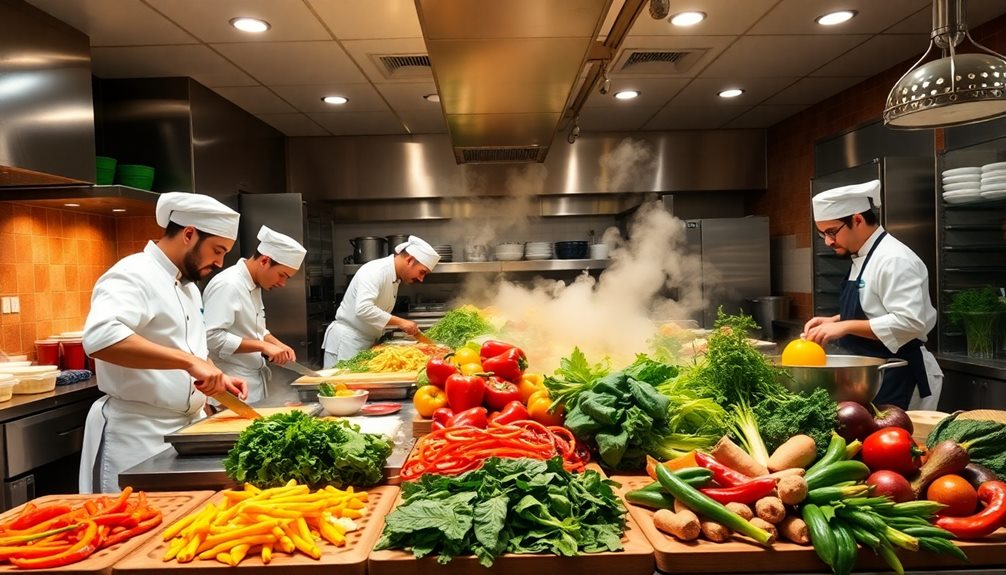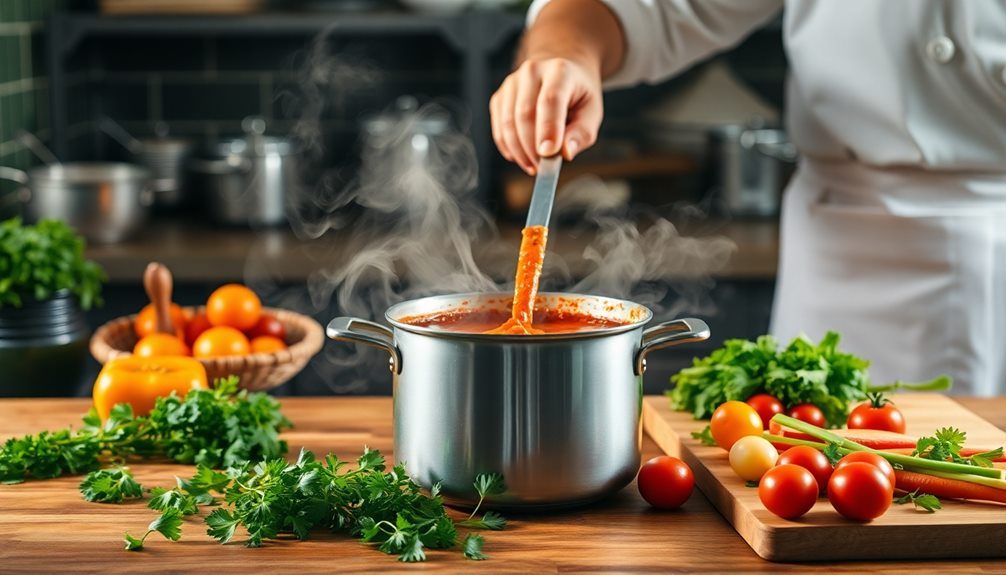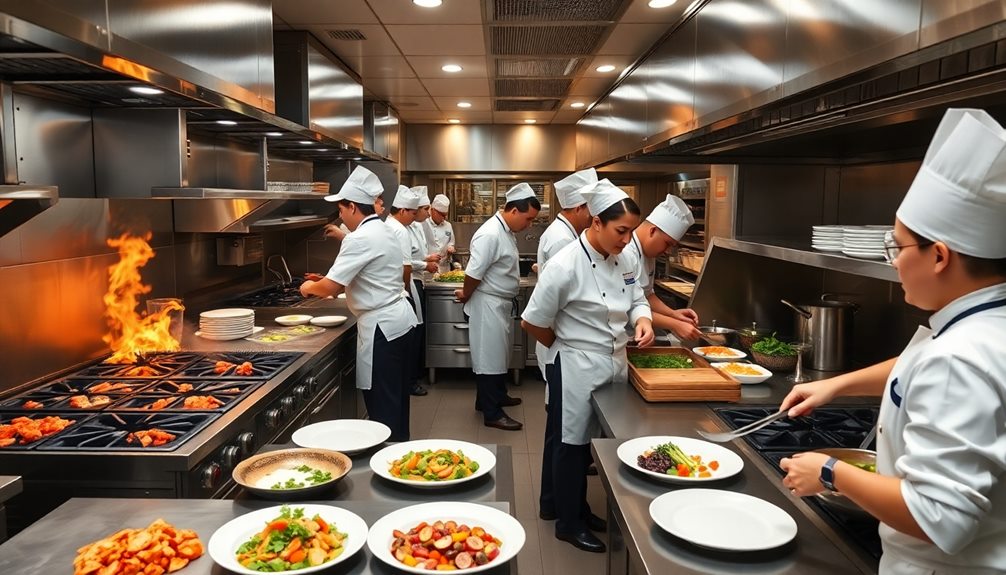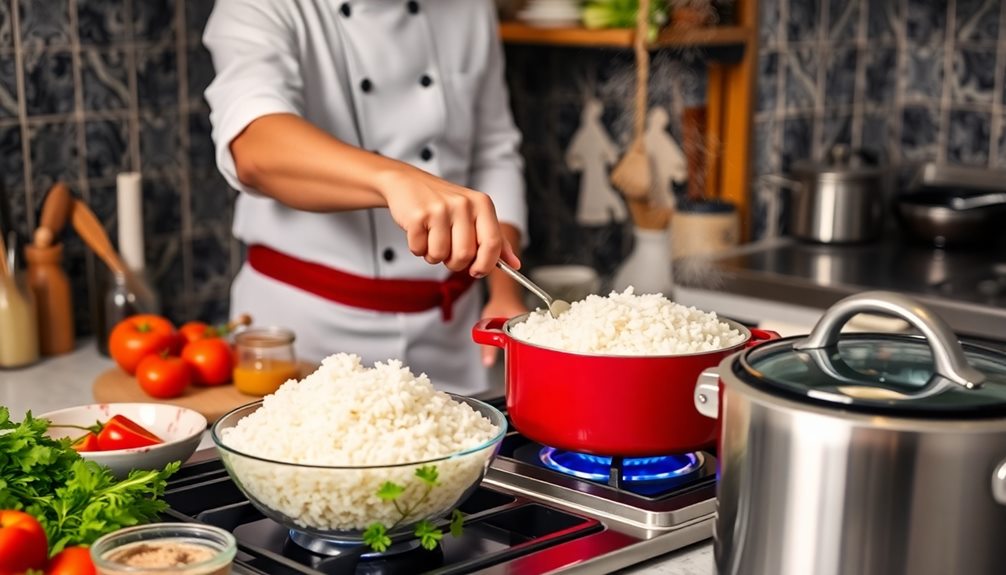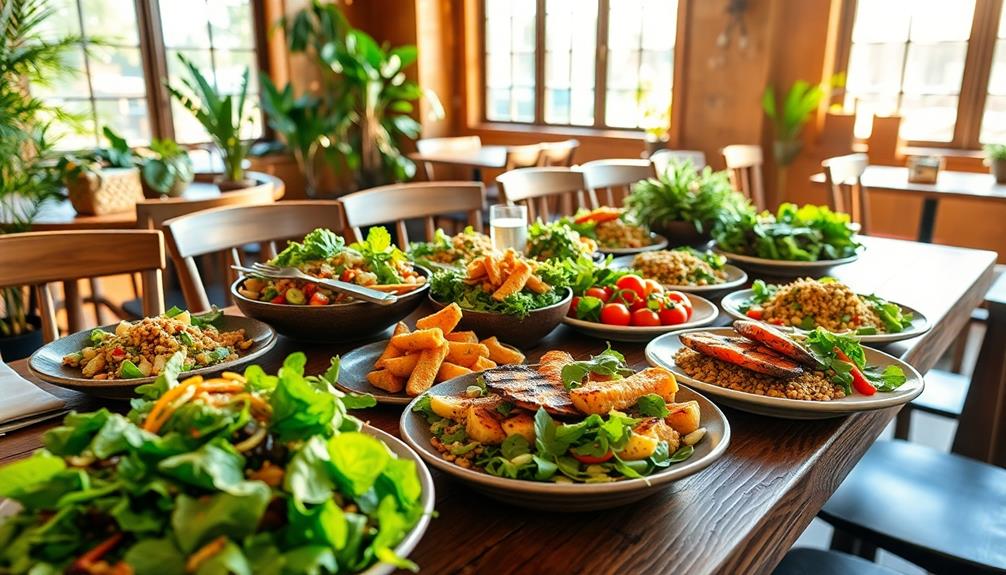To prep vegetables efficiently, you'll want to utilize strategic techniques. Start by washing produce using a vinegar solution to remove contaminants. Employ specialized tools like mandolins and food processors for consistent cuts and faster prep. Organize your station with all necessary equipment within reach and designate areas for different types of vegetables to avoid cross-contamination. Proper storage is key; use clear bins and recognize which veggies need refrigeration. Investing in high-quality tools can greatly speed up the process and guarantee consistency. There's much more you can implement to enhance your kitchen efficiency and safety.
Key Takeaways
- Implement specialized tools like mandolins and food processors for quick and uniform vegetable cutting.
- Establish a sanitized washing station to ensure thorough cleaning and prevent cross-contamination of produce.
- Pre-cut vegetables during off-peak hours to streamline service and reduce prep time during busy periods.
- Organize the prep station efficiently, keeping equipment within reach and labeling storage areas to enhance workflow.
- Invest in high-quality equipment to ensure durability and maintain hygiene standards while speeding up preparation tasks.
Importance of Vegetable Preparation
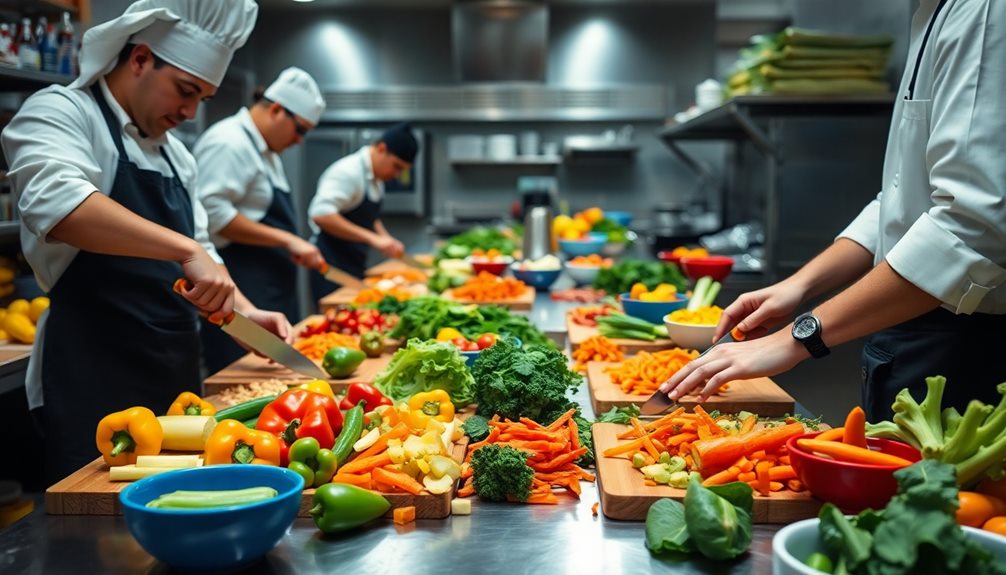
When you prep vegetables efficiently, you're not just saving time; you're also guaranteeing food safety and enhancing the overall dining experience. Proper vegetable preparation is essential in preventing foodborne illnesses, as it involves removing dirt, bacteria, and pesticides that can compromise the health of your customers. By taking these precautions, you create a safer environment in your restaurant, which translates into customer trust and satisfaction.
Moreover, when you focus on proper storage techniques, you're helping maintain the freshness and quality of your ingredients. This not only elevates the flavor and texture of your dishes but also keeps customers coming back for more.
Efficient vegetable prep reduces labor time, allowing your team to concentrate on cooking and providing excellent customer service, especially during peak hours.
Using specialized equipment like vegetable slicers and peelers can streamline the process, improving consistency and efficiency in your kitchen. In addition, practices such as batch cooking and effective storage minimize food waste, contributing to your restaurant's operational success.
Emphasizing the importance of vegetable preparation guarantees that you're meeting both food safety standards and customer expectations every time you serve a meal.
Techniques for Washing Produce
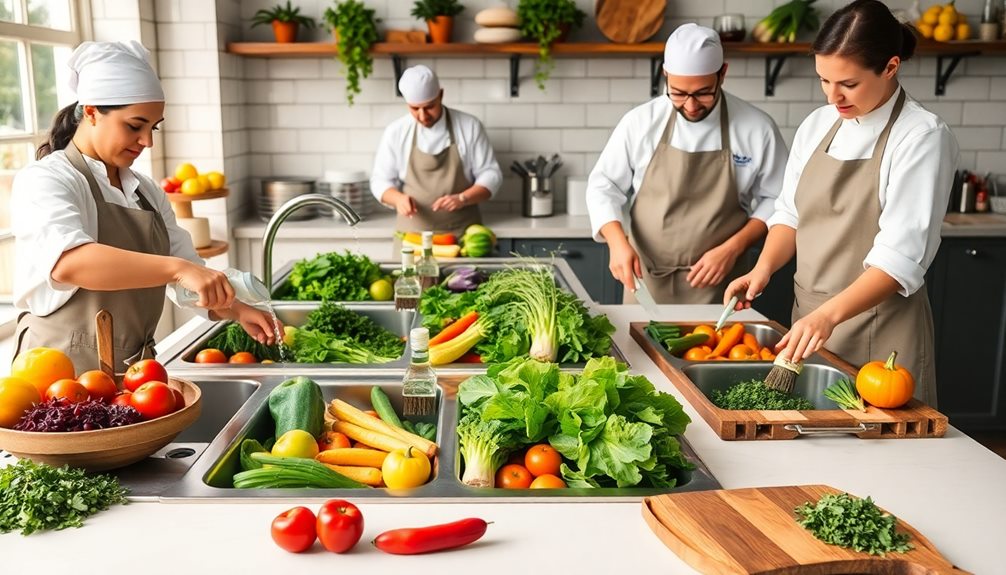
Properly washing produce is an essential step in vegetable preparation that directly impacts food safety and quality. To guarantee your fruits and vegetables are clean, start by soaking them in a vinegar solution or a designated produce-washing product for at least 30 seconds. This helps eliminate dirt, bacteria, pesticides, and other contaminants. After soaking, rinse them thoroughly under cold water.
Setting up a designated, sanitized produce-washing station is vital to prevent cross-contamination on your prep surfaces and equipment.
For firm vegetables like potatoes and carrots, scrub them with a vegetable brush to remove stubborn dirt. Delicate items, such as tomatoes and mushrooms, only need a gentle rinse to avoid damage.
Leafy greens require a bit more attention. Soak them in cold water to dislodge any dirt, then either pat them dry with a clean towel or use a salad spinner to remove excess moisture.
This extra step guarantees that your greens aren't only clean but also ready for use in your dishes. By following these techniques, you can greatly enhance food safety while preparing fresh produce in your restaurant.
Efficient Cutting Methods
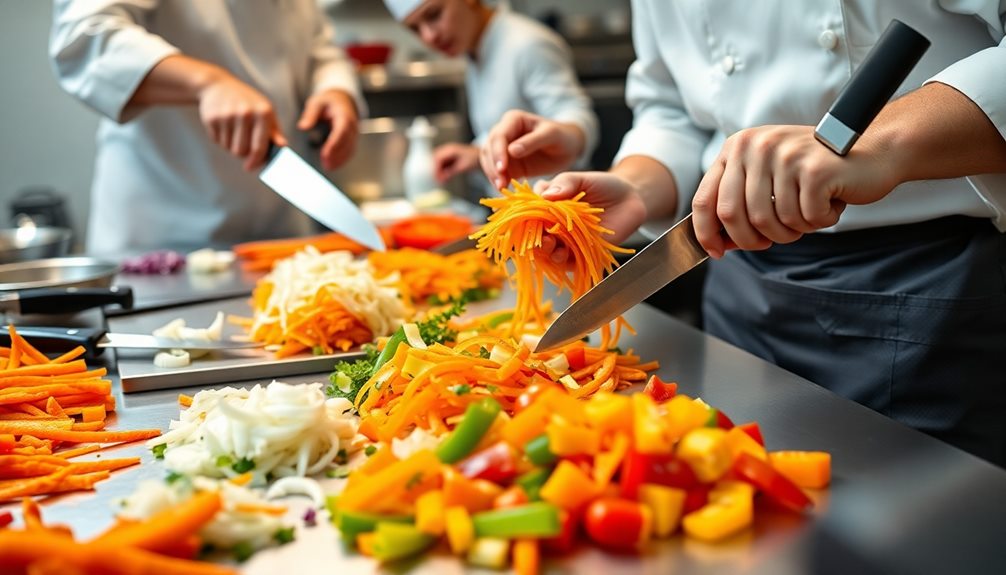
Efficient cutting methods can greatly streamline vegetable prep in any restaurant kitchen. By utilizing specialized cutting tools like mandolins and food processors, you can achieve uniform cuts quickly, enhancing both presentation and cooking consistency.
The "rocking" technique with a chef's knife is another valuable skill; it allows you to chop efficiently, especially when working with herbs and small vegetables.
To optimize service during busy periods, consider pre-cutting vegetables into desired sizes during off-peak hours. This approach not only reduces wait times for customers but also keeps your food prep station running smoothly.
Investing in color-coded cutting boards is essential, as they help prevent cross-contamination while making it quicker to switch between different types of vegetables.
Training your staff in knife skills and efficient cutting techniques is vital. Not only does this improve preparation speed, but it also minimizes food waste, ensuring you get the maximum yield from each vegetable.
Organizing the Prep Station
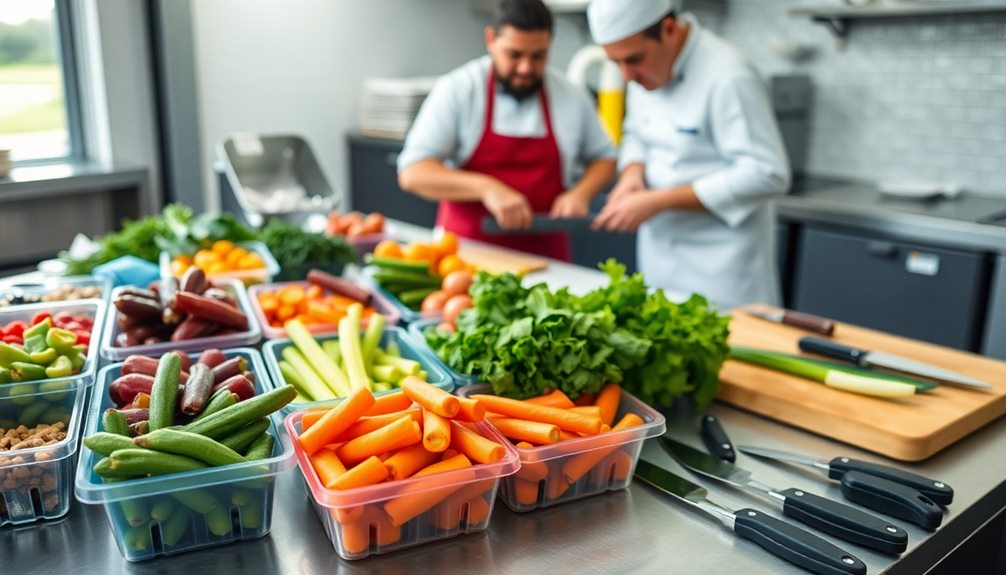
Organizing your prep station is fundamental for streamlining vegetable preparation in a busy kitchen. Start by gathering necessary kitchen equipment like knives, cutting boards, peelers, a scrap bin, and a trash can. Having these tools within arm's reach not only saves time but also enhances efficiency.
Additionally, guaranteeing proper airflow around your prep station can help maintain ideal working conditions, similar to how air purifier maintenance dos and don'ts emphasize the importance of ventilation for performance.
Next, consider incorporating specialized equipment, such as pineapple corers and mandolins, to simplify tasks that can be time-consuming. By designating specific areas for different types of vegetables and clearly labeling them, you can prevent cross-contamination, which is critical for maintaining food safety standards.
Regularly maintaining and cleaning your prep station equipment is essential for prime performance and minimizing contamination risks. A clean station improves overall food quality and guarantees that your vegetables remain fresh and safe for use.
Storage Best Practices
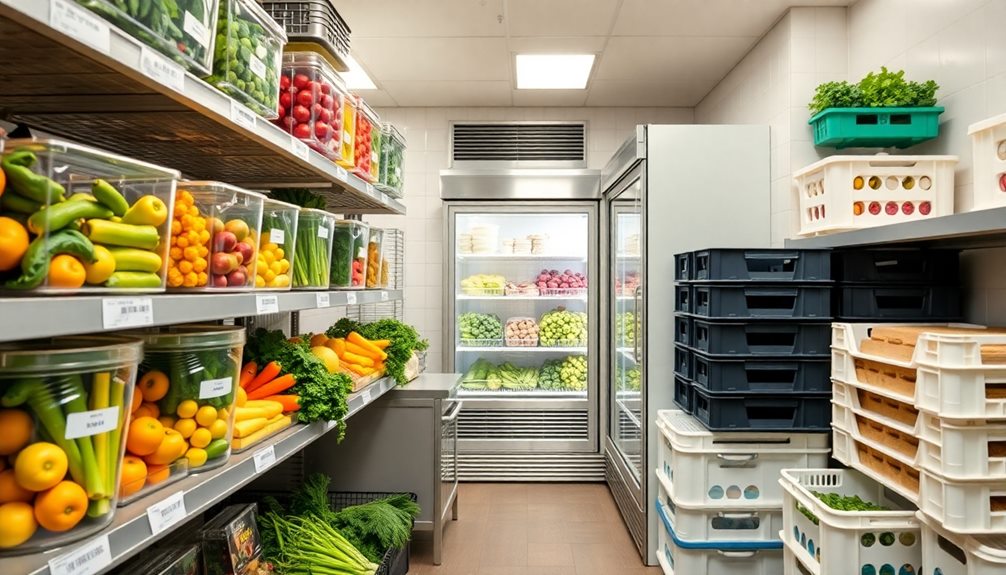
Storing vegetables correctly can drastically enhance their taste, texture, and longevity. To implement effective storage best practices, start by knowing which vegetables prefer refrigeration and which don't. For instance, garlic, onions, and tomatoes should stay out of the fridge, while cucumbers and carrots thrive in cooler temperatures.
Your prep station should include small, clear bins in the refrigerator for organized storage. Keep mushrooms in their original packaging or a paper bag to maintain their freshness. For herbs, consider placing them in a glass jar filled with water to keep them vibrant.
Also, break down vegetables like cauliflower and brussels sprouts before storing them; this makes cooking easier later. Don't forget to save the greens from beets and carrots for salads, maximizing your vegetable use.
Lastly, collect vegetable scraps such as peels and stems in a freezer bag. This not only enhances efficiency but also allows you to create a nutrient-rich DIY vegetable broth, reducing waste in the kitchen.
Benefits of Specialized Equipment
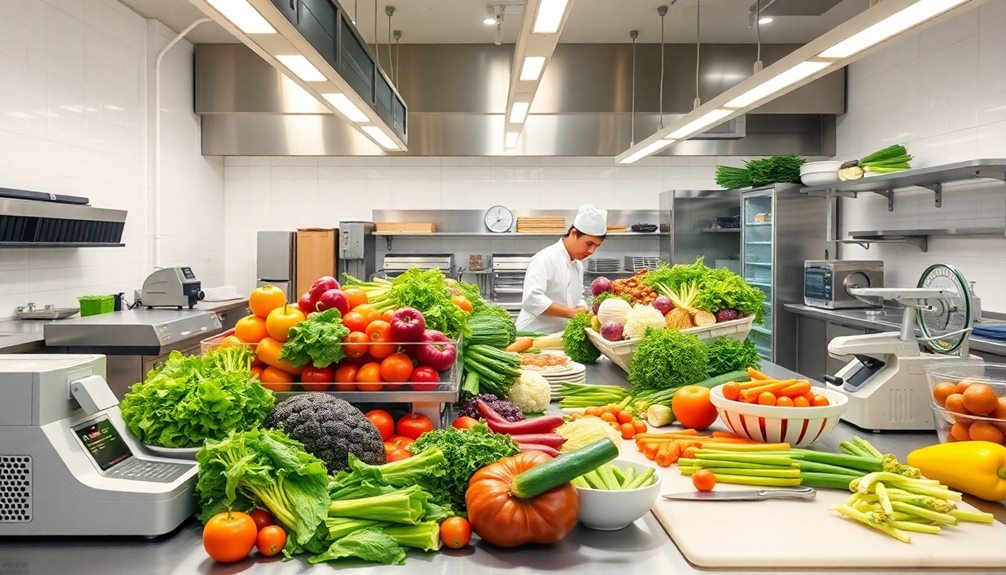
When you use specialized equipment like vegetable slicers and choppers, you'll save a significant amount of time during prep.
These tools not only speed up the process but also guarantee that every piece of produce is cut consistently, leading to better presentation and cooking.
Time-Saving Tools
Specialized equipment can transform your vegetable prep process, making it faster and more efficient. By investing in the right tools, you can greatly reduce labor time and improve the quality of your food prep.
For instance, using vegetable choppers not only speeds up the cutting process but also guarantees uniformity, much like how coffee enhances athletic performance. Here are some time-saving tools to take into account:
- Vegetable choppers and slicers: Speed up the cutting process and maintain consistency.
- Pineapple corers: Simplify the task of prepping fruits, enhancing presentation.
- Mandolines: Guarantee uniform vegetable sizes for better plating and cooking.
- Commercial-grade food processors: Handle shredding, grating, and pureeing with ease.
- Easy-to-clean tools: Minimize downtime during peak service hours.
These tools not only save time but also allow your kitchen staff to focus on more complex cooking tasks.
With specialized equipment, you can prep large quantities of vegetables quickly, making sure that your dishes maintain a high standard. Plus, high-quality tools can withstand the rigors of a busy kitchen, reducing the need for constant maintenance.
When you streamline your prep process, you boost overall kitchen efficiency, which is vital during busy service times. Embrace these time-saving tools, and watch your food prep transform for the better!
Consistent Food Preparation
Consistently using specialized equipment in your kitchen can dramatically improve the quality of food preparation. Tools like vegetable slicers and peelers reduce labor time by quickly and uniformly processing vegetables, freeing your staff to tackle other essential tasks.
When you implement specialized equipment, you're not just speeding up the prep process; you're also enhancing consistency in food sizing. This guarantees even cooking and elevates the presentation of your dishes, which is vital in the food industry.
Moreover, high-quality commercial kitchen equipment is designed for easy cleaning, promoting hygiene and minimizing the risk of cross-contamination during vegetable prep. By streamlining operations with these tools, your restaurant can efficiently handle larger volumes of prep work, especially during peak service times.
This efficiency translates to better overall kitchen performance and can lead to improved customer satisfaction, as patrons receive their meals promptly without sacrificing quality.
Integrating specialized tools into your food prep routines allows you to maintain high standards in both speed and quality. In a competitive market, it's these small details that can set your restaurant apart and keep your customers coming back for more.
Adapting to Labor Shortages

Labor shortages have forced many restaurants to rethink their operations, especially in vegetable preparation. To cope with these challenges, you can adopt several strategies that streamline your kitchen processes, enabling your team members to focus on what really matters—serving customers.
Understanding the importance of store hours can also help restaurants plan their ingredient purchases effectively, guaranteeing that fresh produce is always available when needed.
Consider these effective approaches:
- Simplify Menus: Reducing the variety of dishes minimizes the amount of vegetable prep needed.
- Utilize Fresh Cut Produce: Pre-prepared vegetables help save time and effort, allowing your staff to concentrate on cooking and customer interaction.
- Standardize Procedures: Training all team members in consistent vegetable prep techniques boosts efficiency and guarantees quality.
- Invest in Automation: Use specialized equipment, like vegetable choppers and peelers, to handle labor-intensive tasks quickly.
- Strengthen Supply Chains: Establish reliable sources for pre-prepared vegetables to maintain ingredient availability and service quality.
Frequently Asked Questions
How Do Restaurants Prep Vegetables?
When you prep vegetables in a restaurant, you'll chop, slice, and wash them using specialized tools. You'll organize prepped produce in labeled bins, ensuring quick access while maintaining freshness and food safety for your dishes.
How Do Restaurants Pre-Cook Vegetables?
Imagine a bustling kitchen where vegetables dance in boiling water. You'll pre-cook them by blanching or steaming, then store them safely. This way, you'll serve dishes faster without sacrificing flavor or texture.
How Do Chefs Prepare Vegetables?
When you prepare vegetables, start by washing and peeling them. Then, chop using efficient tools. Organize your station to prevent cross-contamination, and consider using scraps to enhance flavors and reduce waste in your kitchen.
What Is the Secret to Restaurant Vegetables?
The secret to restaurant vegetables lies in precision. Imagine a painter's palette; each vegetable's cut and color must harmonize. With specialized tools and techniques, you create vibrant dishes that captivate diners and elevate their experience.
Conclusion
In the bustling kitchen, efficiently prepping vegetables is like conducting a symphony—every note must harmonize to create a delicious melody. By mastering washing techniques, cutting methods, and smart organization, you can turn chaos into culinary artistry. Embracing specialized equipment and innovative strategies not only enhances productivity but also helps you adapt to labor shortages. So, get your prep station in tune, and watch your dishes shine as they take center stage!
